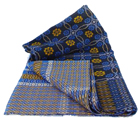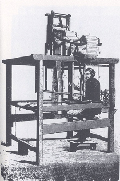| |||
America’s earliest coverlets were brought over with the first European immigrants and were in daily use. It wasn’t long before the original coverlets had to be replaced by new ones. Virtually every home had a simple four-harness loom. Coverlets were the earliest form of home weaving in the New World. The most popular coverlet in America’s earliest days were the Overshot, which had natural linen warp and vegetable-dye single color wool homespun weft. Designs were composed of handsome displays of squares, stripes and diamonds.
The Jacquard process in its early days, before mechanization took over, enabled the individualistic spirit of the American weavers to manifest itself in the art of the loom. Weavers quickly became adept at the Jacquard process and were making their own cards with their own patterns. After the completion of the coverlet, the weaver studied the pattern he created and gave it a name. This personalization did lead to some confusion in attributing the exact community in which the weaver did his or her work, but it does a lot to tell us of the social mores of the times. Pattern names such as “Christian and Heathen”, “Eagle and Independence Hall” and “True Boston Town” suggest the importance to the early American citizen of religion mixed with pride of home, community and newly established freedom. For some fine examples, search for Coverlets on Dig Antiques. About Pat Martin Here are a few interesting references on Coverlets:
|
||||
|
Early Technology - Happy Thanksgiving! As we read more about the Jacquard loom and how it works, we discovered that the ability to change the pattern of the loom's weave by simply changing cards was an important conceptual precursor to the development of computer programming. The Jacquard was invented in 1801 and it had great influence on both the creation of more intricate coverlets and 150 years later on computers. With our marriage of technology and love of antiques, it exciting to find other ways that Americana and computers interrelate! With Thanksgiving, the quintessential American holiday this week, we'd like to thank you for your support and wish you a happy holiday filled with family and friends. Each month, Dig Antiques usage continues to grow. If you are a dealer, please consider a sponsorship to help us continue to provide this service to the country, Americana and folk art antiques community. |
|
Search Showcase Have you been digging for antiques recently? |
|
October 2010 Top Searches Below is a summary of the twenty most popular search phrases last month.
1. stoneware crocks |
|
Sponsors |
|
Thank you to the following current advertisers for their support of Dig Antiques:
Ames Gallery If you are interested in supporting Dig Antiques through advertising, please click here. |
|
Contact Us |
|
For general information:
Website: www.digantiques.com |
|
© 2010 Dig Antiques. All rights reserved. |


